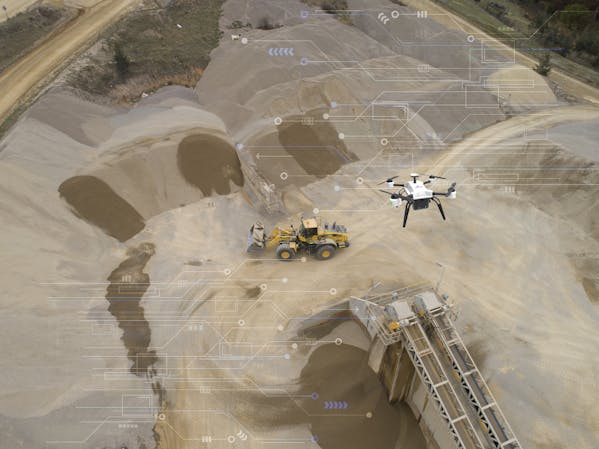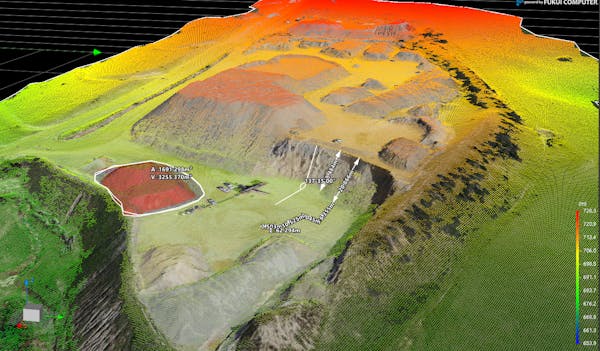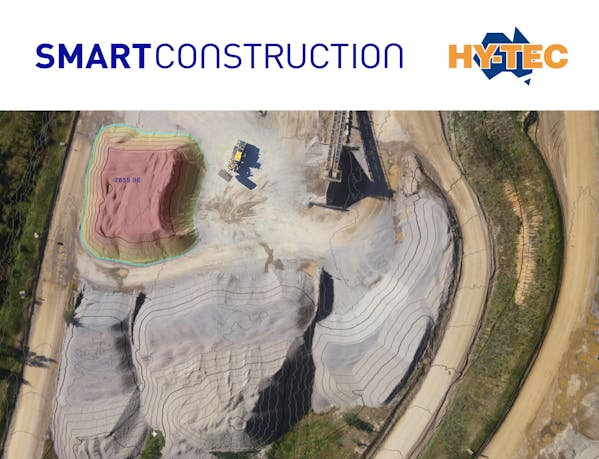Leading quarry operator Hy-Tec is seeing major benefits in site safety, along with community engagement, efficiency and productivity advances, through the use of Komatsu’s SMARTCONSTRUCTION EDD drone technology for stockpile management, regulatory compliance and site auditing in its quarries throughout NSW.
Hy-Tec, one of 19 respected bands within the ASX-list Adbri Limited Group portfolio, operates quarries throughout the east coast of Australia to supply aggregates and sands to the infrastructure, commercial, civil and residential construction sectors, as well as supporting the Group’s 95 pre-mix concrete plants. In total, Adbri’s group of companies operates 44 quarries across Australia.
In late 2018, Komatsu began aerial surveying and stockpile volume reporting of Hy-Tec’s Austen quarry at Hartley, west of the Blue Mountains.
Following this initial success, it now provides twice-yearly aerial surveys and stockpile volume reports at Austen and the company’s other six quarries in NSW: Penrose, Tinda Creek, Dunbogan, Grants, Yarrabee and Tumbulgum.

These aerial surveys are primarily to provide volume reporting of stockpiles, but also help confirm each operation is complying with its licensed extraction limits, and to identify potential offset areas – as well as giving efficiency, production and site management benefits.
The surveys are carried out by James Mackenzie, Project Solution Consultant with UNISI, a joint venture between Komatsu and Topcon distributor Position Partners, using Komatsu’s SMARTCONSTRUCTION technology and offerings.
Komatsu’s EDD (EveryDay Drone) technology is a high precision UAV survey system that provides industry-leading super-fast onsite processing using SMARTCONSTRUCTION’s Edge technology.
Craig McDonald, Quarry Manager at Hy-Tec’s Austen quarry, said the aerial surveying process using Komatsu drones was very simple and straightforward.
“James comes out to the quarry twice a year and does our stockpile surveys, as well as providing aerial photos and surveying for potential offset areas, and future quarry development,” he said.
“When he does the stockpile surveys, James sets up the same points each time, flies around the stockpiles, then sends us a draft report of the volumes and materials in each stockpile.

“We update them according to our actual material stockpile numbers and volume, and compare them with our previous drone surveys,” said McDonald.
Hy-Tec’s quarries use these aerial surveys to measure stockpiles gains/losses for accounting and auditing purposes.
“Each six months, they show us the volume that’s in each stockpile. We know how much we’ve extracted and sold, and if there’s a discrepancy – say, has it been misallocated, or gone to a different customer – we can track it down.”
He said using Komatsu’s EDD technology was resulting in significant safety benefits and time savings.
“Previously, we’d have a surveyor on the ground with a staff, taking about two days to survey the stockpiles. Now James is on site for maybe two to three hours.

“It’s very cost-competitive, a lot faster and safer, because James is well out of the way of fixed and mobile equipment,” McDonald said.
Hy-Tec’s quarries are also using the technology to monitor extraction limits – particularly in areas that are relatively inaccessible or have dangerously steep slopes – to ensure the quarries always within their approved extraction limits.
“The drone can fly over and physically check boundaries, as well as monitor how wide and deep we are extracting, to show that we are not going too deep or working out of area,” he said.
“As well, at Austen, we have 15m benches into the quarry, and it’s on a very steep hill – so it’s not a very nice place to have to survey on foot.
“The other application we’re using it for is aerial photography for our rehabilitation works, so we can monitor progress every six months.”
In addition to these survey-related benefits, McDonald said the regularly updated aerial visuals of the site were proving invaluable in operating and managing the quarry on a day-to-day basis.

“When we’re having our regular toolbox meetings, they are a really useful way to communicate with the team on what we’re planning with pit development, or the next stages of the quarry,” he said.
“When we have haul road changes, we can communicate easily with other users of the area, show them the aerial image and where they have to get to.
“And going forward, we’re going to incorporate some of this technology into our induction process.
“So, rather than using traditional handwritten maps, we can go through images showing what’s happening, where people will be working, and pinpoint areas of concern, such as high benches, bench identification, drill work areas and so on.
“We can also use them for driver induction and traffic management flow plans; we can show someone who’s come on site to load some aggregates exactly where the stockpiles are, and how to safely get there.
“Again, that’s so much better than the old-style handwritten maps.”
McDonald sees benefits in using this technology across improvements in safety, productivity, efficiency and costs, plus a whole host of extra benefits that have only become apparent since the quarry has been using it.
.JPG_282?width=600&height=306)
“Really, the sky’s the limit in what you could be using this technology for,” he said.
“There’s potential for our load and haul team to use it to help optimise cycle times, identify optimum routes and gradients, pinpoint areas of hold-ups and choke-points, geological faults and so on.
“And again, we can be using them even more in toolbox meetings so that everyone’s on the same page.
“Going forward, I think we could benefit more from using EDD technology’s RL (Reference Level) capabilities, working in with our excavation equipment,” McDonald said.
“So we could set our excavator to only go to RL100 and no more, so that we are extracting 100% of what we’ve paid to drill and blast, plus it would ensure we always had nice level benches and floors.”
Another unexpected benefit of the aerial drone technology has been its ability to provide a ‘fly-through’ of the total quarry operation for our engagement program.
“We had an open day recently, and in preparation for that, we flew the whole process, from the rock face through to the crushing operations and stockpiles, then onto loading material and trucking it off site through the gate,” he said.

“We used this for the open day for our local community, and also for a recent board members’ meeting, and as a presentation for potential investors.”
Looking to the statewide picture, Ethan Pettiford, Hy-Tec’s NSW Quarry Operations Manager, said the aerial surveying package from Komatsu worked very well for the company.
“In terms of mapping our quarry operations, the technology works extremely well, giving us all we need to survey and monitor our quarry operations throughout NSW.
“James comes and does all our flyovers; he’s very helpful, and the operation is completely pain-free,” said Pettiford.
About Komatsu’s EDD technology
Komatsu SMARTCONSTRUCTION’s EDD technology uses purpose-designed Explore1 precision 3D mapping drones to provide total site solutions for customers.
Komatsu’s highly specialised EDD UAV technology is the only commercial quadcopter capable of creating 3D point clouds with sub-5cm accuracy, without the use of ground control points.
It’s coupled with Edge 1 technology allowing Komatsu to process rapid high-accuracy point clouds in remote areas without internet connectivity or the need for a high-performance laptop, representing a major advance in data processing.
The system is able to record current as-built data and provide high-resolution imagery for daily updates and construction progress, plus cut and fill volume reporting.
Komatsu SMARTCONSTRUCTION’s EDD UAV capabilities include:
Site survey cut/fill and stockpile volume calculations, allowing users to:
- - Measure quantities to confirm cut and fill estimates
- - Identify potential delays and verifying truckload estimates
- - Carry out continuous as-built surveys at the beginning, middle and end of projects.
Progress tracking and site logistics, allowing:
- - Billing verification and work-in-place tracking
- - Site logistics overlay and site constraint analysis
- - Quicker and more accurate site planning.
Online collaboration and communication, including:
- - Frequent map updates for improved safety and coordination with outside agencies
- - File exports for data manipulation, reporting and site meetings.